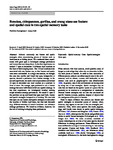Bonobos, chimpanzees, gorillas, and orang utans use feature and spatial cues in two spatial memory tasks
| dc.contributor.author | Kanngiesser, P | |
| dc.contributor.author | Call, J | |
| dc.date.accessioned | 2020-06-22T11:40:48Z | |
| dc.date.available | 2020-06-22T11:40:48Z | |
| dc.date.issued | 2010 | |
| dc.identifier.issn | 1435-9448 | |
| dc.identifier.issn | 1435-9456 | |
| dc.identifier.other | 3 | |
| dc.identifier.uri | http://hdl.handle.net/10026.1/15802 | |
| dc.description.abstract |
Animals commonly use feature and spatial strategies when remembering places of interest such as food sources or hiding places. We conducted three experiments with great apes to investigate strategy preferences and factors that may shape them. In the first experiment, we trained 17 apes to remember 12 different food locations on the floor of their sleeping room. The 12 food locations were associated with one feature cue, so that feature and spatial cues were confounded. In a single test session, we brought the cues into conflict and found that apes, irrespective of species, showed a preference for a feature strategy. In the second experiment, we used a similar procedure and trained 25 apes to remember one food location on a platform in front of them. On average, apes preferred to use a feature strategy but some individuals relied on a spatial strategy. In the final experiment, we investigated whether training might influence strategy preferences. We tested 21 apes in the platform set-up and found that apes used both, feature and spatial strategies irrespective of training. We conclude that apes can use feature and spatial strategies to remember the location of hidden food items, but that task demands (e.g. different numbers of search locations) can influence strategy preferences. We found no evidence, however, for the role of training in shaping these preferences. | |
| dc.format.extent | 419-430 | |
| dc.format.medium | Print-Electronic | |
| dc.language | en | |
| dc.language.iso | en | |
| dc.publisher | Springer Science and Business Media LLC | |
| dc.subject | Spatial memory | |
| dc.subject | Cues | |
| dc.subject | Spatial strategies | |
| dc.subject | Great apes | |
| dc.title | Bonobos, chimpanzees, gorillas, and orang utans use feature and spatial cues in two spatial memory tasks | |
| dc.type | journal-article | |
| dc.type | article | |
| plymouth.author-url | https://www.webofscience.com/api/gateway?GWVersion=2&SrcApp=PARTNER_APP&SrcAuth=LinksAMR&KeyUT=WOS:000276603500003&DestLinkType=FullRecord&DestApp=ALL_WOS&UsrCustomerID=11bb513d99f797142bcfeffcc58ea008 | |
| plymouth.issue | 3 | |
| plymouth.volume | 13 | |
| plymouth.publication-status | Published | |
| plymouth.journal | Animal Cognition | |
| dc.identifier.doi | 10.1007/s10071-009-0291-3 | |
| plymouth.organisational-group | /Plymouth | |
| plymouth.organisational-group | /Plymouth/Faculty of Health | |
| plymouth.organisational-group | /Plymouth/Faculty of Health/School of Psychology | |
| plymouth.organisational-group | /Plymouth/REF 2021 Researchers by UoA | |
| plymouth.organisational-group | /Plymouth/REF 2021 Researchers by UoA/UoA04 Psychology, Psychiatry and Neuroscience | |
| plymouth.organisational-group | /Plymouth/REF 2021 Researchers by UoA/UoA04 Psychology, Psychiatry and Neuroscience/UoA04 Psychology, Psychiatry and Neuroscience MANUAL | |
| plymouth.organisational-group | /Plymouth/REF 2021 Researchers by UoA/UoA04 Psychology, Psychiatry and Neuroscience/UoA04 REF peer reviewers | |
| plymouth.organisational-group | /Plymouth/Users by role | |
| plymouth.organisational-group | /Plymouth/Users by role/Academics | |
| dc.publisher.place | Germany | |
| dcterms.dateAccepted | 2009-10-23 | |
| dc.identifier.eissn | 1435-9456 | |
| dc.rights.embargoperiod | Not known | |
| rioxxterms.versionofrecord | 10.1007/s10071-009-0291-3 | |
| rioxxterms.licenseref.uri | http://www.rioxx.net/licenses/all-rights-reserved | |
| rioxxterms.type | Journal Article/Review |


